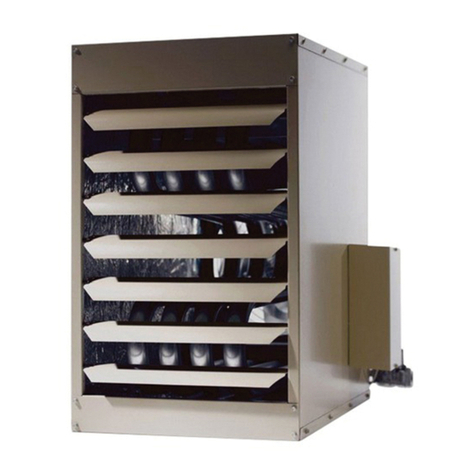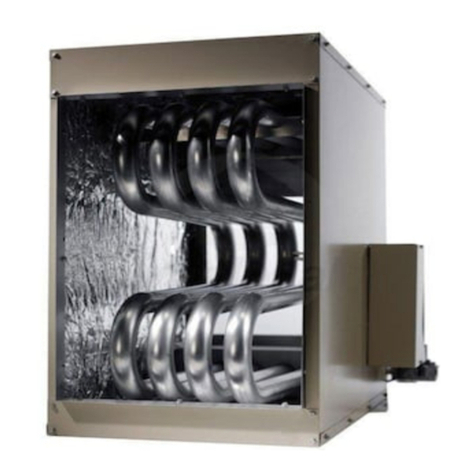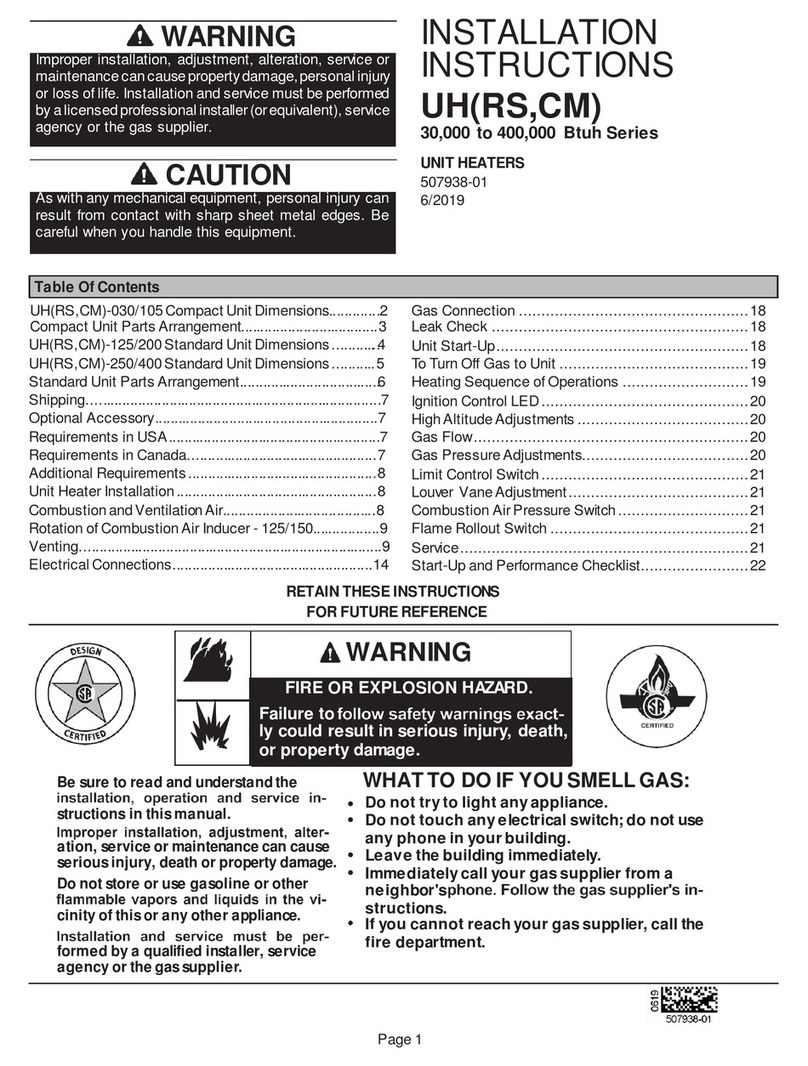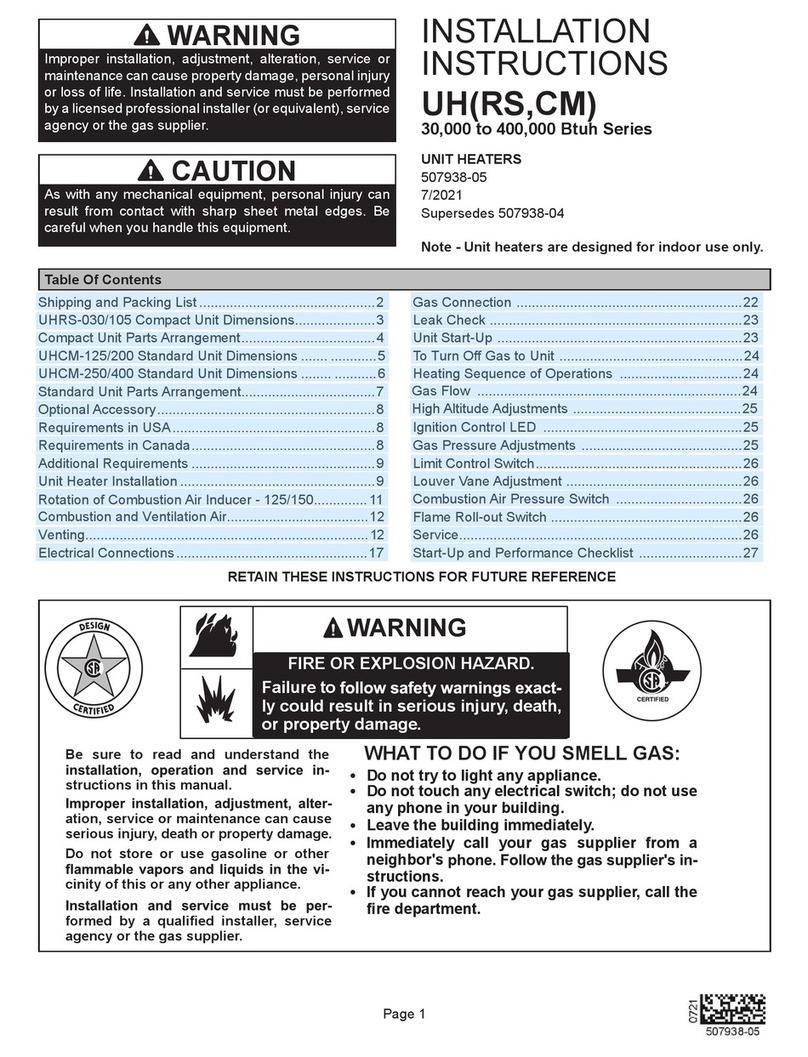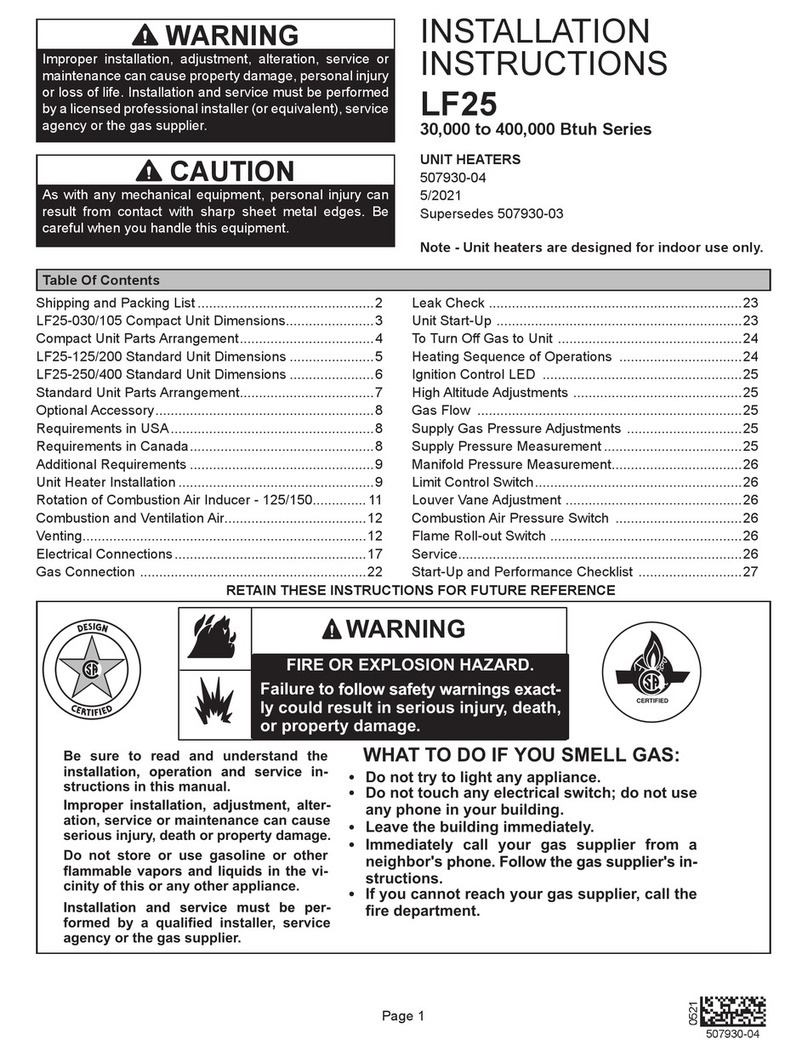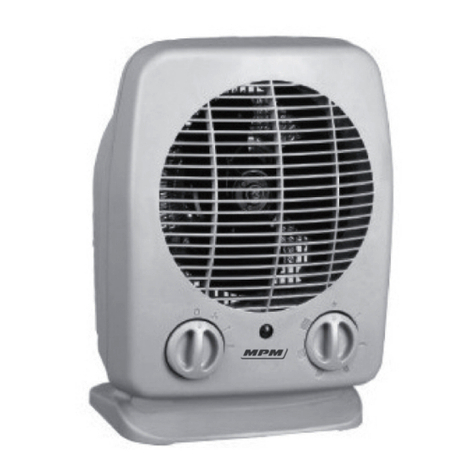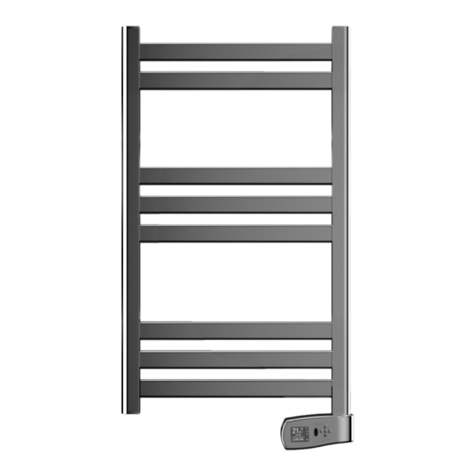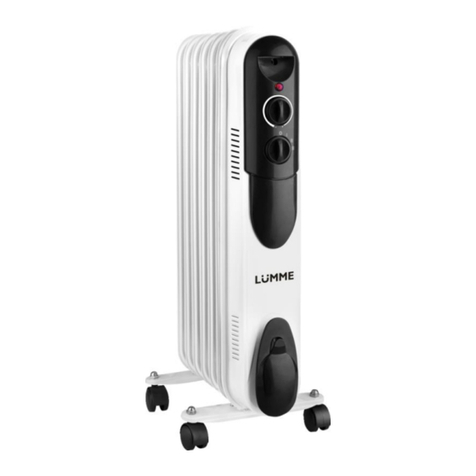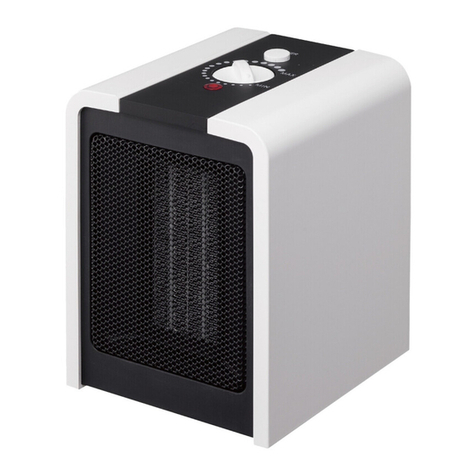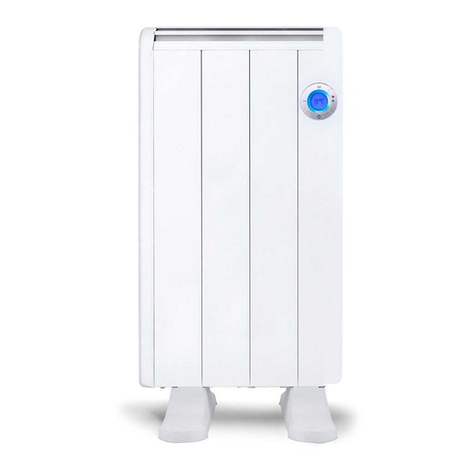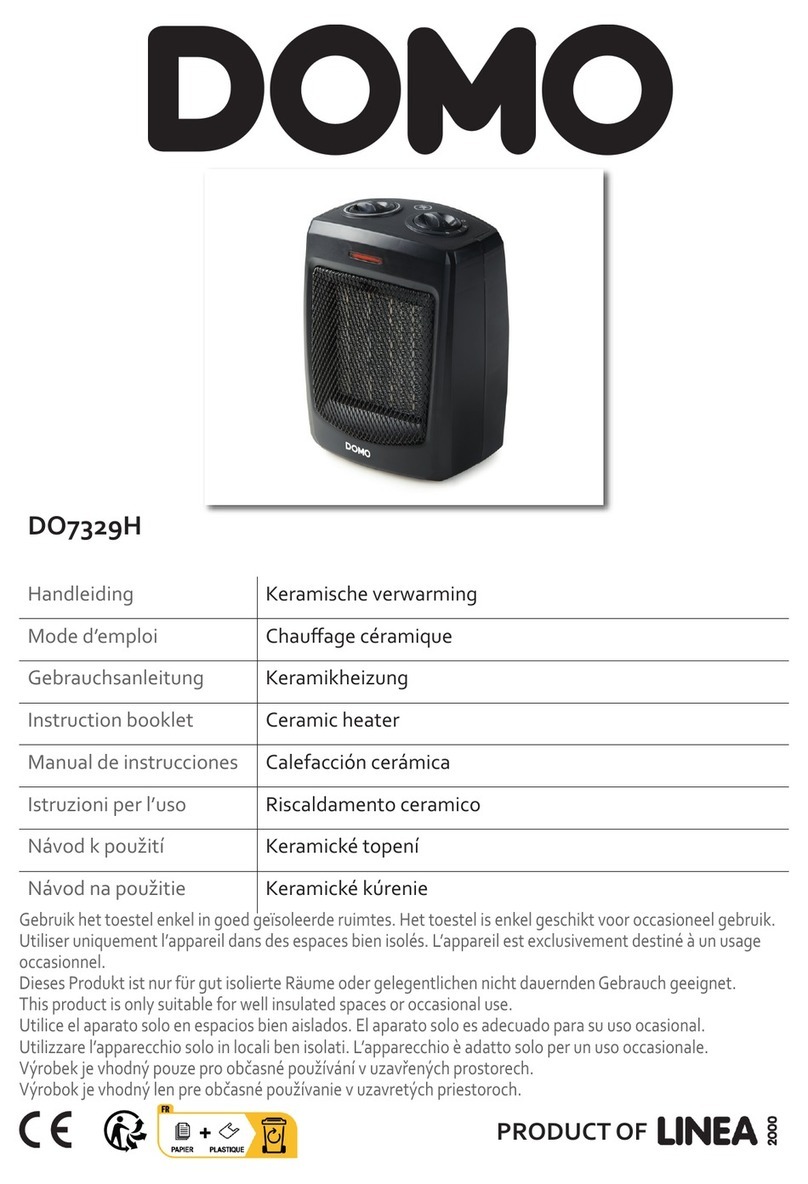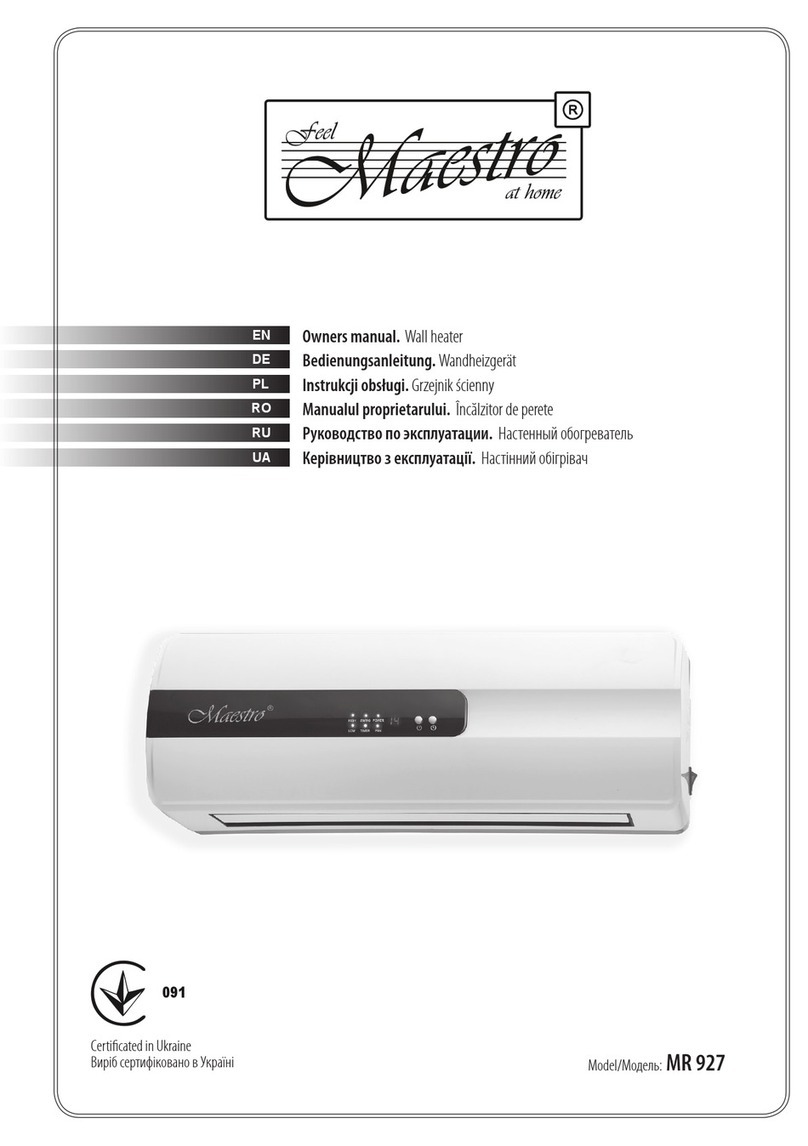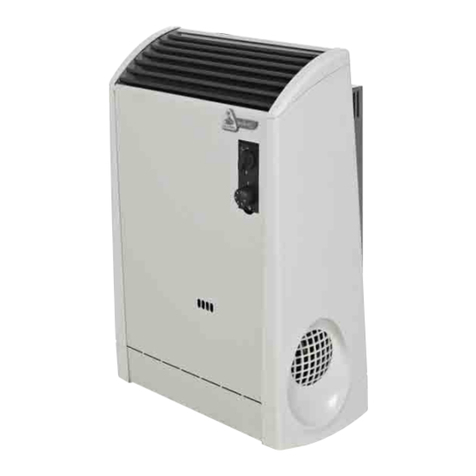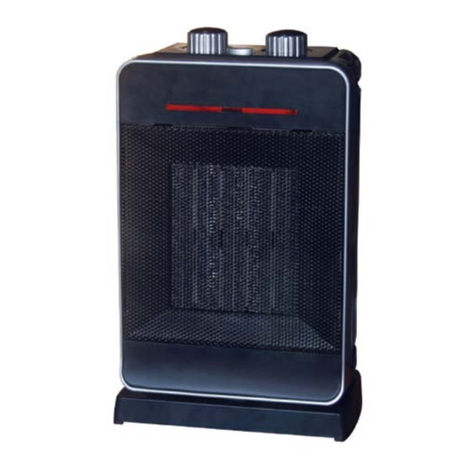Adp Foa Series User manual

INSTALLATION
INSTRUCTIONS
FOA
40,000 to 125,000 Btuh Series
SEPARATED COMBUSTION
UNIT HEATERS
IM-FOA-45-125-0653334-08
April 2018
Supersedes 065333407
Table of Contents
Unit Dimensions . . . . . . . . . . . . . . . . . . . . . . . . . . . . . . . . . . . 2
Shipping . . . . . . . . . . . . . . . . . . . . . . . . . . . . . . . . . . . . . . . . . . 3
Optional Accessory . . . . . . . . . . . . . . . . . . . . . . . . . . . . . . . . . 3
CSA Requirements in USA . . . . . . . . . . . . . . . . . . . . . . . . . . . 3
CSA Requirements in Canada . . . . . . . . . . . . . . . . . . . . . . . . . 4
Additional Requirements . . . . . . . . . . . . . . . . . . . . . . . . . . . . . 5
Unit Heater Installation . . . . . . . . . . . . . . . . . . . . . . . . . . . . . . 5
Combustion and Ventilation Air . . . . . . . . . . . . . . . . . . . . . . . 6
Exhaust Vent and Combustion Air Inlet . . . . . . . . . . . . . . . . . 6
Electrical Connections . . . . . . . . . . . . . . . . . . . . . . . . . . . . . . 13
Typical Wiring Diagram . . . . . . . . . . . . . . . . . . . . . . . . . . . . 14
Gas Connection . . . . . . . . . . . . . . . . . . . . . . . . . . . . . . . . . . . 15
Leak Check . . . . . . . . . . . . . . . . . . . . . . . . . . . . . . . . . . . . . . 15
Unit Start−Up . . . . . . . . . . . . . . . . . . . . . . . . . . . . . . . . . . . 16
To Turn Off Gas to Unit . . . . . . . . . . . . . . . . . . . . . . . . . 17
Heating Sequence of Operations . . . . . . . . . . . . . . . . . . 17
Ignition Control LED . . . . . . . . . . . . . . . . . . . . . . . . . . . 17
High Altitude Adjustments . . . . . . . . . . . . . . . . . . . . . . . 17
Gas Flow . . . . . . . . . . . . . . . . . . . . . . . . . . . . . . . . . . . . . 18
Gas Pressure Adjustments . . . . . . . . . . . . . . . . . . . . . . . . 18
Limit Control . . . . . . . . . . . . . . . . . . . . . . . . . . . . . . . . . 18
Louver Vane Adjustment . . . . . . . . . . . . . . . . . . . . . . . . 18
Combustion Air Pressure Switch . . . . . . . . . . . . . . . . . . 18
Flame Rollout Switch . . . . . . . . . . . . . . . . . . . . . . . . . . 18
Service . . . . . . . . . . . . . . . . . . . . . . . . . . . . . . . . . . . . . . 18
Start−Up and Performance Checklist . . . . . . . . . . . . . . . 19
Warranty . . . . . . . . . . . . . . . . . . . . . . . . . . . . . . . . . . . . . 20
RETAIN THESE INSTRUCTIONS
FOR FUTURE REFERENCE
WARNING
FIRE OR EXPLOSION HAZARD.
Failure to follow
safety warnings exactly
could result in serious injury, death, or
property damage.
Be sure to read and understand the installation,
operation and service instructions in this manual.
Improper installation, adjustment, alteration, service
or maintenance can cause serious injury, death or
property damage.
Do not store or use gasoline or other flammable
vapors and liquids in the vicinity of this or any
other appliance
Installation and service must be performed by a
qualified installer, service agency or the gas
supplier.
WHAT TO DO IF YOU SMELL GAS:
•Do not try to light any appliance.
•Do not touch any electrical switch; do not use any
phone in your building.
•Leave the building immediately.
•Immediately call your gas supplier from a neighbor’s
phone. Follow the gas supplier’s instructions.
•If you cannot reach your gas supplier, call the fire
department.

Unit Dimensions
FOA*−45, -60, -75 UNIT DIMENSIONS
(NATURAL GAS & PROPANE)
7−1/4
(184)
F
HANGING
BRACKETS
F 7
(178)
MOUNTING SLOTS (Typical)
5/16 x 3 Inches (8 x 76 mm)
3−1/4
(83) (2) 3
(76) 1
(25)
1/2
(13)
AIR
FLOW
1
18−1/2
(470)
HEAT
EXCHANGER
B 1
(25)
18−1/2
(470)
HANGING
BRACKETS (2) GAS
INLET
5−3/4
(146)
TOP VIEW
29
(737)
1
(25)
SERVICE
ACCESS
DOOR FLUE
OUTLET C
A
E
BURNER VIEWING PORT
ADJUSTABLE THUMB
SCREW
D COMBUSTION AIR
INLET
LOUVERS SIDE VIEW ELECTRICAL
BOX BACK VIEW DIRECT DRIVE FAN
DIMENSION
45
60 / 75
A
12 (305)
17 (432)
B
5-1/2 (140)
6-1/2 (165)
C
7-3/4 (197)
10-1/4 (260)
D
1-3/4 (44)
3-1/4 (83)
E
5-1/4 (133)
5-3/4 (146)
F
13 (330)
14-1/2 (368)
2

Model
No.
FOA*-100
FOA*-125
in.
mm
A
21
533
B
8−1/2
216
FOA*−100 & −125 UNIT DIMENSIONS
(NATURAL GAS & PROPANE)
THREADED STUDS 24−7/16
(621)
5−1/2
(140)
AIR FLOW
32−3/8
(822) 21−5/16
(541)
HEAT
EXCHANGER
7−1/4 (184)
1/2
(13)
TOP VIEW
32−3/8
(822)
THUMB
SCREW 7−3/8
(187)
36−1/2
(927)
FLUE
OUTLET
DIRECT
DRIVE FAN
B
SERVICE
ACCESS
DOOR
ELECTRIC
BOX A
7 (178)
ADJUSTABLE
LOUVERS BURNER VIEWING
PORT
SIDE VIEW GAS INLET
7−3/4
(197) COMBUSTION AIR INLET
BACK VIEW
Shipping
Shipping contents includes completely assembled heater,
installation instructions, warranty certificate and two
mounting brackets (shipped loose with −45 units). Check the
unit for shipping damage. The receiving party should contact
the last carrier immediately if any shipping damage is found.
Optional Accessory
Units require a changeover kit when the unit is to be used
with LP/propane gas. The kit is ordered separately.
CSA Requirements in USA
Installation of gas unit heaters must conform with local
building codes or, in the absence of local codes, with the
current edition of ANSI Z223.1, National Fuel Gas Code.
Installation in aircraft hangers must be in accordance with the
current edition of ANSI/NFPA No. 409, Standard for Aircraft
Hangers.
Installation in parking structures must be in accordance with
the current edition of ANSI/NFPA No. 88A, Standard for
Parking Structures.
3

Installation in repair garages must be in accordance with the
current edition of ANSI/NFPA No. 88B, Standard for Repair
Garages.
These units are approved for installation in residential
applications. Residential applications are defined as
installations for heating non−living spaces that are attached
to, adjacent to or part of a structure that contains space for
family living quarters. For installation in a residential garage,
unit must be installed so that burners and ignition source are
located no less than 18" (457mm) above floor. Heater must
be located or protected to avoid physical damage by vehicles.
Refer to the current edition of ANSI Z223.1, National Fuel
Gas Code.
The National Fuel Gas Code (ANSI Z223.1) is available
from: American National Standard Institute Inc.
11 West 42nd Street
New York, NY 10036
Authorities having jurisdiction should be consulted before
installation.
These unit heaters are CSA International design−certified.
These unit heaters are certified for installation clearances to
combustible material as listed in Table 1 and on unit rating
plate.
Accessibility and service clearances must be observed in
addition to fire protection clearances.
All electrical wiring and grounding for unit must be in
accordance with the regulations of the current edition of
ANSI/NFPA No. 70, National Electric Code.
The National Electric Code is available from:
National Fire Protection Association
1 Batterymarch Park
PO Box 9101
Quincy, MA 02269−9101
CSA Requirements in Canada
These instructions are intended only as a general guide and
do not supersede local codes in any way. Authorities having
jurisdiction should be consulted before installation. The
installation must conform with local building codes or, in the
absence of local codes, with the current edition of CSA−B149
installation compliance codes. All electrical wiring and
grounding for the unit must also comply with the current
edition of CSA C22.1, Canadian Electrical Code.
These unit heaters are CSA International design−certified for
the installation clearances listed on the rating plate and in
table 1. Adequate clearance must be provided around the
appliance and around air inlet terminals. Provision shall be
made for service accessibility.
NOTE − Fire protection clearances may be exceeded to
provide additional space for service and accessibility.
GARAGE / WAREHOUSE INSTALLATIONS
1) In a storage area, clearance from heaters to combustible
materials must be such that the combustible material
must not attain a temperature above 160°F (71°C) by
continuous operation of the unit.
WARNING
Combustible materials that are affected by exposure
to temperatures LESS than 160°F (plas-
tics, plastic wrap, styrofoam, cardboard, etc.)
must be stored well away from this heater. Dis-
charge air temperatures for these units can approach
200°F.
2) Maintain an 8-foot (2m) minimum clearance from the
floor to the bottom of the heater. Refer to the current
edition of CSA−B149 for installation compliance codes.
TABLE 1
UNIT CLEARANCES
Top
Side
Access Panel
Bottom
Back
Flue
in
mm
in
mm
in
mm
in
mm
in
mm
in
mm
1
25
1
25
18
457
0
0
18
457
6
152
4

AIRCRAFT HANGER
1) In an area where aircraft are housed or serviced, a
10−foot (3m) minimum clearance from the highest
surface of the aircraft to bottom of the heater must be
maintained.
2) In other areas, an 8−foot (2m) minimum clearance from
the floor to bottom of heater must be maintained.
3) Heaters should be located so that they are protected
from damage from aircraft or other appliances needed
for servicing of aircraft. Refer to requirements of the
enforcing authorities.
RESIDENTIAL
These units are approved for installation in residential
applications. Residential applications are defined as
installations for heating non−living spaces that are attached to,
adjacent to or part of a structure that contains space for family
living quarters. For installation in a residential garage, unit
must be installed so that burners and ignition source are
located no less than 18" (457mm) above floor. Heater must be
located or protected to avoid physical damage by vehicles.
Refer to the current edition of CSA-B149 for installation
compliance codes.
The appliance shall not be installed downstream from
evaporator coils or cooling units.
Unit is shipped ready for installation. FOA*-45, -60, & -75
units may be installed as shown in figure 1 or rotated 180°
depending on desired location as governed by clearances,
vent connection, air direction, gas supply, electrical supply
and service accessibility.
1) If installing unit in a rotated position:
a. Remove and retain screws securing door and rotate
door 180°.
b. Resecure door using existing screws.
c. Rotate louvers to direct airflow as desired.
2) Choose location for mounting brackets.
3) Remove and retain three screws along top edge (bottom
edge when rotated) of front of unit.
4) Align screw holes on mounting bracket with holes along
top edge (either upright or rotated) of unit. Use existing
screws to secure one mounting bracket to front of unit.
Secure other mounting bracket to back of unit using
screws provided in bag assembly.
5) To support unit, secure mounting bracket to ceiling joist
or truss. Unit may also be supported using support rods
as shown in figure 1.
UNIT HEATER INSTALLATION
Be sure to check with local codes and ordinances for additional
requirements.
Additional Requirements
MOUNTING BRACKETS
(45, 60, 75 ONLY) SUPPORT
RODS
The Commonwealth of Massachusetts stipulates the
following additional requirements:
1) Gas furnaces shall be installed by a licensed plumber or
gas fitter only.
2) The gas cock must be “T handle" type.
Unit Heater Installation
NORMAL POSITION
ALL MODELS
WARNING
Improper installation, adjustment, alteration, service or
maintenance can cause property damage, personal injury or
loss of life. Installation and service must be performed by a
licensed professional installer (or equivalent), service
agency or the gas supplier.
MOUNTING BRACKETS
(45, 60, 75 ONLY) SUPPORT
RODS
CAUTION
As with any mechanical equipment, personal injury can
result from contact with sharp sheet metal edges. Be careful
when you handle this equipment.
OPTIONAL ROTATED
POSITION (45, 60, 75 ONLY)
FIGURE 1
5

FOA*-100 and −125 units may not be rotated. Threaded
inserts (3/8" X 16) are provided in the top of the cabinet. Two
of the inserts are located along one edge of the cabinet and
two more are located in the divider panel between the heat
exchanger and control compartments.
1) Cut threaded rods to desired length and thread a 3/8" nut
onto the rod.
2) Slide a flat washer on the the threaded rod after the nut
(7/16" I.D. X 1" O.D. X 1/16" THK washer).
3) Screw the four rods into the threaded inserts on the unit.
4) Tighten nuts to secure rods.
Combustion and Ventilation Air
Adequate facilities for supplying air for combustion and
ventilation must be provided in accordance with the current
edition of ANSI Z223.1, section 5.3 and CSA-B149
installation compliance codes, or applicable provisions of
local building codes.
All gas−fired appliances require air to be used for
combustion. In many buildings today, there is a negative
indoor air pressure caused by exhaust fans, etc. If sufficient
quantities of combustion air are not available, the heater or
another appliance will operate in an inefficient manner,
resulting in incomplete combustion which can result in the
production of excessive carbon monoxide.
CAUTION
Insufficient combustion air can cause headaches, nausea,
dizziness, asphyxiation or death.
This unit must be provided with a combustion air pipe that is
connected to the outside atmosphere. Outdoor air used for
combustion must be free of the following substances or the
life of the heat exchanger will be adversely affected: chlorine,
carbon tetrachloride, cleaning solvent, halogen refrigerants,
acids, cements and glues, printing inks, fluorides, paint
removers, varnishes, or any other corrosives.
Exhaust Vent and Combustion Air Inlet
NOTE − The vent is a passageway, vertical or nearly so,
used to convey flue gases from an appliance, or its vent
connector, to the outside atmosphere. The vent connector is
the pipe or duct that connects a fuel−gas−burning appliance
to a vent or chimney. The combustion air inlet is a pipe that
connects the appliance to the outside atmosphere to convey
oxygen from the air to the appliance burner.
NOTE − Local codes may supersede any of these provisions.
GENERAL RECOMMENDATIONS AND
REQUIREMENTS
Unit heaters must be vented in compliance with the latest
edition of the National Fuel Gas Code (NFPA 54 / ANSI
Z223.1) in the USA and with CSA−B149.1 codes in Canada,
as well as applicable provisions of local building codes, and
the following instructions.
An exhaust outlet flange and combustion air inlet flange are
attached to the back of the unit.
A single−wall vent connector may be used between the
furnace and the vertical vent pipe in all applications;
however, single-wall vent material cannot be used for
vertical vent piping in residential applications.
U.L.−approved Category III venting materials must be
used in all residential applications which include
horizontal vent piping.
A single−wall vent pipe used as a vent connector in
residential or commercial applications, or as a vertical vent
in commercial applications, must have all seams and joints
sealed with pressure−sensitive aluminum tape or silicone
rubber sealant. Aluminum tape must meet the provisions of
SMACNA AFTS-100-73 Standards. The aluminum tape
must have a temperature rating of 400°F (204°C). Silicone
rubber sealant must have a temperature rating of 482°F
(250°C), i.e., Dow Corning RTV−736 or equivalent.
All joints must be secured with at least two
corrosion−resistant screws. All joints must be checked for gas
tightness after installation.
Single−wall vent pipe used as vertical vent in commercial
applications must not pass through any attic, interior wall,
concealed space, or floor.
VERTICAL VENTS USING METAL VENT PIPE −
COMMERCIAL AND RESIDENTIAL
These compact unit heaters are listed as Category 1
appliances for vertical vent installations. See table 3 for
vertical venting requirements.
1) These unit heaters are to be used with NFPA− or
ANSI−approved chimneys or U.L.−listed type B−1 gas
vents, or listed chimney lining systems for gas venting
where applicable, as well as the modifications and
limitations listed in figure 2. Seal single-wall vent
material according to General Recommendations and
Requirements section. Air inlet pipe may be
single−wall metal pipe or U.L.-listed single-wall metal
flex connector.
6

Number. of
Elbows
Feet
Meters
1
25
7.6
2
20
6.1
3
15
4.6
4
10
3.0
5
5
1.5
2) The vent connector shall be 3" (76mm) diameter on 40K
Btuh units, 4” (100mm) diameter on 60 & 75K Btuh
units, and 5" (127mm) diameter on 100 and 125K Btuh
units.
The air inlet pipe shall be 3" (76mm) diameter on 40K
Btuh units and 4" (100mm) diameter on 60, 75, 100 and
125K Btuh units.
3) Keep the vent connector runs as short as possible with a
minimum number of elbows. Refer to the current
edition of ANSI Z223.1 or CSA-B149 installation
compliance codes for maximum vent and vent connector
lengths. Horizontal run of the vent connector from the
combustion air inducer to the chimney/vent cannot
exceed the values in table 2. Single-wall vent connector
shall not be insulated.
TABLE 2
MAXIMUM HORIZONTAL VENT CONNECTOR
AND HORIZONTAL VENT LENGTHS
4) The entire length of a single-wall metal vent connector
shall be readily accessible for inspection, cleaning and
replacement.
5) If a single-wall vent is used in an unheated area, it shall
be insulated with a minimum of 1/2" thick foil−faced,
1−1/2# density insulation. Failure to do so will result in
condensation of flue gases.
6) The unit may be vented vertically as a single appliance or
in a common vent with other gas−fired appliances. In
common venting situations, vent connectors for other
appliances must maintain a 4" (102mm) vertical
separation between the vent connectors. Refer to
common venting tables in the current editions of ANSI
Z223.1 or CSA−B149 installation compliance codes for
proper vent size.
7) Clearance to combustible material is 6" (152mm) for
single−wall vent material except where a listed
clearance thimble is used. Clearance to combustible
material for type B-1 vent or factory-built chimney is
per manufacturer’s instructions. Clearance to
combustible material is 1” on vertical sections of the
concentric vent/adapter/cap kit.
8) The vent connector shall be supported without any dips
or sags. Vertical vents shall be supported in accordance
with their listing and manufacturers’ instructions. All
horizontal vent connector runs shall have a slope up to
the vertical vent of at least 1/4" per foot (1mm per
50mm).
9) All vertical type B−1 vents, single−wall vertical vents
(commercial applications), or listed chimney lining
systems must be terminated with a U.L.−listed (or other
equivalent agency) vent cap or listed roof assembly.
See table 3.
10) The vent must extend at least 3 feet (1m) above the
highest point where it passes through a roof of a
building. The vent must also extend at least 2 feet (1m)
higher than any part of a building within a horizontal
distance of 10 feet (3m) unless otherwise specified by
ANSI Z223.1 or CSA-B149 installation compliance
codes. The vent must extend at least 5 feet (2m) above
the highest connected equipment flue collar.
EXHAUST VENT AND AIR INLET TERMINATIONS ON SINGLE−WALL VERTICAL VENT RUNS
(Commercial Applications Only)
SINGLE−WALL VENT PIPE WITH
SINGLE−WALL TERMINATION SINGLE−WALL VENT PIPE WITH
DOUBLE−WALL (TYPE B−1) TERMINATION
ROOF FLASHING
ROOF PITCHED
FROM 0" TO 45"
NOTE − Combustion air inlet termination
should be a minimum of 12" (304mm) below
exhaust vent termination.
ROOF FLASHING
ROOF PITCHED
FROM 0" TO 45"
2" CLEARANCE
THIMBLE
12" MAX CLEARANCE TO BE
AS SPECIFIED ON
TYPE “B" VENT PIPE.
SEAL JOINT BETWEEN SINGLE−WALL VENT AND B" VENT TER-
MINATION AND THE OPEN SPACE BETWEEN THE SINGLE WALL
VENT PIPE AND THE OUTER PIPE OF THE “B" VENT TERMINATION.
FIGURE 2
7

HORIZONTAL VENTING
NOTE − Common venting is not allowed when horizontally
venting the unit heater.
If the unit heater is to be horizontally vented, a positive
pressure may be created in the vent. The unit heater, when
installed with horizontal venting, will perform as a category
III appliance. See table 4 for horizontal venting requirements
1) In residential applications which include horizontal
venting, use only special vent materials approved for
use with Category III appliances for the exhaust pipe.
Refer to table 5 for venting components.
In commercial applications, single-wall (26 GSG)
galvanized or equivalent stainless steel vent pipe sealed
per these instructions, OR listed special vent for
Category III appliances may be used for the exhaust
pipe.
Single-wall vent pipe or U.L.−listed single−wall flex
connector can be used for the combustion air inlet in
both residential and commercial applications.
2) In residential and commercial applications, the
exhaust pipe diameter for horizontal installations shall
be 3" (76mm) on FOA−45 units, 4” (100mm) on −60 &
−75 units, and 5" (127mm) on −100 and −125 units.
In residential and commercial applications, the
combustion air inlet pipe diameter for horizontal
installations shall be 3" (76mm) on FOA-45 units and
4" (127mm) on −60, −75, −100 & −125 units.
3) The minimum horizontal vent length is 5 feet (2m).
4) Refer to table 2 for maximum horizontal vent lengths.
5) If possible, do not terminate the horizontal vent through
a wall that is exposed to prevailing wind. Exposure to
excessive winds can affect unit performance. If such a
termination is necessary, use a wind block to protect the
vent termination from direct winds.
6) Horizontal vent termination must be free from
obstructions and at least 12" (305mm) above grade level
and maximum snow height.
7) Do not install a horizontal vent termination directly
below roof eaves or above a public walkway, or any
other area where condensate dripping may be
troublesome and may cause some staining. Avoid
windows where steam may cause fogging or ice
buildup.
8) Minimum clearance for horizontal vent termination
from any door, window, gravity air inlet, gas or electric
meter, regulators, and relief equipment is 4 feet (1m) for
United States installations.
In Canada, horizontal vent termination must have a
minimum 6-foot horizontal clearance from gas and
electric meters and relief devices.
Refer to latest editions of the ANSI Z223.1 or
CSA−B149 for installation compliance codes or check
with local authorities having jurisdiction.
9) Vent termination must be a minimum of 4 feet (1m)
below, or 4 feet (1m) horizontally, from any soffit or
under-eave vent.
10) Vent termination must be a minimum of 6 feet (2m)
from an inside corner formed by two exterior walls. If
possible, leave a 10−foot (3m) clearance.
11) Vent termination must be a minimum of 10 feet (3m)
from any forced air inlet (includes fresh air inlet for
other appliances, such as a dryer).
12) When termination is routed through combustible wall,
vent termination must be supported using a listed
clearance thimble. Inside edge of vent termination must
be at least 12" (305mm) from outside wall.
13) All horizontal vents which use special vent pipe for use
with Category III appliances must terminate with an
approved Category III tee. Opening end must face
downward.
14) In commercial applications, clearance to combustible
material is 6" (152mm) for single-wall vent material
except where a U.L.−listed thimble is used. Follow
manufacturer’s instructions for clearance to combustible
for type B−1 vent or factory-built chimney.
15) For horizontal venting, the vent pipe shall be supported
with hangers no more than 3 feet (1m) apart to prevent
movement after installation.
16) Select a wall termination point that will maintain 1/4"
(6mm) rise per foot (305mm) slope of horizontal run
of vent pipe.
8

17) For upward sloped vent, a condensate tee and drain
must be installed within the first 5 feet (2m) from the
unit heater to protect the appliance. If a flexible
condensate drain line is used, the drain line must include
a loop filled with water to prevent combustion products
from entering the structure. If the unit is shut down for
an extended period of time and will be exposed to sub-
freezing temperatures, the condensate may freeze.
18) In areas where authorities having jurisdiction permit, a
downward slope of maximum 1/4" per foot is also
acceptable. Condensate drainage can be collected in a
tee pipe section (figure 4) with drain loop similar to one
used for upward slope vent, or allowed to drip through
the vent termination, if permitted by authorities (figure
5).
CONDENSATE DRAIN THROUGH TEE PIPE AND DRAIN LOOP
UPWARD SLOPE ON HORIZONTAL VENT −− RESIDENTIAL OR COMMERCIAL APPLICATION
EXHAUST VENT
TERMINATION
TEE
12 INCHES MIN.
(30.5cm) BETWEEN
AIR INLET AND
EXHAUST
TERMINATION
(horizontal or
vertical)
12 INCHES MIN.
(30.5cm) ABOVE
HIGHEST
SNOWFALL
12 INCHES
(30.5cm)
MIN.
LISTED WALL
THIMBLE
THROUGH
COMBUSTIBLE
WALL
COMBUSTION AIR
INLET TEE
DRAIN
TEE
DRAIN LOOP WITH
WATER TRAP TO
CONDENSATE DRAIN
Category III adaptor must be
installed before optional elbow (if
used).
NOTE − Minimum
horizontal vent length is
5 ft. This does not
include termination tee.
Refer to table 2 for
maximum length and
number of elbows.
GROUND LEVEL
SLOPE = 1/4 IN. PER FOOT
RUN MAXIMUM.
(Provided by installer)
RESIDENTIAL APPLICATIONS −− Venting
must be listed special vent for Category III
appliances.
COMMON VENTING NOT ALLOWED WHEN HORIZONTALLY VENTING THE UNIT HEATER.
FIGURE 3
CONDENSATE DRAIN THROUGH TEE PIPE AND DRAIN LOOP
DOWNWARD SLOPE ON HORIZONTAL VENT − RESIDENTIAL OR COMMERCIAL APPLICATION
NOTE − Minimum
horizontal vent length is
5 ft. This does not include
termination tee. Refer to
table 2 for
maximum length and
number of elbows.
12 INCHES
(30.5cm)
MIN.
DRAIN
TEE
Category III adaptor must be
installed before optional elbow
(if used).
EXHAUST VENT
TERMINATION
TEE
12 INCHES MIN. (30.5cm)
BETWEEN AIR INLET
AND EXHAUST
TERMINATION
(horizontal or vertical)
12 INCHES MIN.
(30.5cm) ABOVE
HIGHEST SNOWFALL
SLOPE = 1/4 IN. PER FOOT
RUN MAXIMUM.
GROUND LEVEL
LISTED WALL
THIMBLE THROUGH
COMBUSTIBLE WALL
DRAIN LOOP WITH
WATER TRAP TO
CONDENSATE DRAIN
(Provided by installer)
COMBUSTION
AIR INLET TEE
RESIDENTIAL APPLICATIONS −− Venting
must be listed special vent for Category III
appliances.
COMMON VENTING NOT ALLOWED WHEN HORIZONTALLY VENTING THE UNIT HEATER.
FIGURE 4
9

CONDENSATE DRAIN THROUGH VENT TERMINATION
DOWNWARD SLOPE ON HORIZONTAL VENT − RESIDENTIAL OR COMMERCIAL APPLICATION
EXHAUST VENT
TERMINATION
TEE
12 INCHES
(30.5cm)
MIN.
Category III adaptor must be
installed before optional elbow
(if used).
COMBUSTION
AIR INLET TEE
12 INCHES MIN. (30.5cm)
BETWEEN AIR INLET
AND EXHAUST
TERMINATION
(horizontal or vertical)
12 INCHES MIN.
(30.5cm) ABOVE
HIGHEST SNOWFALL
SLOPE = 1/4 IN. PER FOOT
RUN MAXIMUM.
GROUND LEVEL
LISTED WALL
THIMBLE THROUGH
COMBUSTIBLE WALL
NOTE − Minimum horizontal
vent length is 5 ft. This does not
include termination tee. Refer to
table 2 for maximum length and
number of elbows.
RESIDENTIAL APPLICATIONS −− Venting
must be listed special vent for Category III
appliances.
COMMON VENTING NOT ALLOWED WHEN HORIZONTALLY VENTING THE UNIT HEATER.
FIGURE 5
Table 3 -Vertical Venting Requirements (FOA 45 - 125)
FOA
Vertical
Commercial
Applications
Model Termination
Type
Flue
Inlet air
Approved Caps
Material Size Material Size Flue Inlet air
-45Two Pipe
Single wall
3" Single
wall 3" Any UL approved caps
Double Wall (B-1)
Concentric
Single wall
* 3"
Single
wall * 3"
Concentric vent kit (4"/7")
Part # 65336800
Double Wall (B-1)
-60, -75Two Pipe
Single wall
4"
Single
wall
4" Any UL approved caps
Double Wall (B-1)
Concentric
Single wall
4"
Single
wall 4"
Concentric vent kit (4"/7")
Part # 65336800
Double Wall (B-1)
-100, -125 Two Pipe
Single wall
5" Single
wall
4" Any UL approved caps
Double Wall (B-1)
Concentric
Single wall
5"
Single
wall
**
4"
Concentric vent kit (5"/8")
Part # 65336900
Double Wall (B-1)
FOA
Vertical
Residential
Applications
Model Termination
Type
Flue
Inlet air
Approved Caps
Material Size Material Size Flue Inlet air
-45Two Pipe Double Wall (B-1) 3"
Single
wall
3" Any UL approved caps
Concentric Double Wall (B-1) * 3" Single
wall
* 3" Concentric vent kit (4"/7")
Part # 65336800
-60, -75Two Pipe Double Wall (B-1) 4"
Single
wall
4" Any UL approved caps
Concentric Double Wall (B-1) 4" Single
wall
4" Concentric vent kit (4"/7")
Part # 65336800
-100, -125 Two Pipe Double Wall (B-1) 5"
Single
wall
4" Any UL approved caps
Concentric Double Wall (B-1) 5"
Single
wall
**
4"
Concentric vent kit (5"/8")
Part # 65336900
* Field supplied 3" to 4" increaser required for connection to concentric adapter
** Field supplied 4" to 5" increaser required for connection to concentric adapter
Note: Vent cap (for two pipe venting systems) 2 required per system
10

Table 4 -Horizontal Venting Requirements (FOA 45 - 125)
FOA
Horizontal
Commercial
Applications
Model Termination
Type
Flue
Inlet air
Approved Caps
Material
Size
Material
Size
Flue
Inlet air
-45Two pipe
Single wall
3" Single wall 3"
Tee
Tee
Cat. III
Cat. III
Cat. III
Concentric
Single wall
* 3" Single wall * 3" Concentric vent kit (4"/7")
Part # 65336800
Cat. III
-60, -75Two pipe
Single wall
4" Single wall 4"
Tee
Tee
Cat. III
Cat. III
Cat. III
Concentric
Single wall
4" Single wall 4" Concentric vent kit (4"/7")
Part # 65336800
Cat. III
-100, -125 Two pipe
Single wall
5" Single wall 4"
Tee
Tee
Cat. III
Cat. III
Cat. III
Concentric
Not available
FOA
Horizontal
Residential
Applications
Model Termination
Type
Flue
Inlet air
Approved Caps
Material
Size
Material
Size
Flue
Inlet air
-45
Two pipe
Cat. III
* 3"
Single wall
3"
Cat. III
Tee
-60, -75
Two pipe
Cat. III
4"
Single wall
4"
Cat. III
Tee
-100, -125
Two pipe
Cat. III
5"
Single wall
4"
Cat. III
Tee
TABLE 5
Category III Horizontal Venting Components
(Required for Residential Horizontal Vent Applications)
FOA
ADP Part
Number Description 45 60
75 100
125
Category III Horizontal Vent Kits [1]
66808901
[2]
VENT KIT, UP SLOPED CAT III (3")
X
66808902
[2]
VENT KIT, UP SLOPED CAT III (4")
X
66808903
[2] VENT KIT, UP SLOPED CAT III (5")
X
66809001
VENT KIT, DOWN SLOPED CAT III (3")
X
66809002
VENT KIT, DOWN SLOPED CAT III (4")
X
66809003
VENT KIT, DOWN SLOPED CAT III (5")
X
Category III Components [3]
66809101
90 DEGREE ELBOW CAT III (3")
X
66809102
90 DEGREE ELBOW CAT III (4")
X
66809103
90 DEGREE ELBOW CAT III (5")
X
66809201
STRAIGHT VENT PIPE 6" LEN (3")
X
66809202
STRAIGHT VENT PIPE 12" LEN (3")
X
66809203
STRAIGHT VENT PIPE 36" LEN (3")
X
66809301
STRAIGHT VENT PIPE 6" LEN (4")
X
66809302
STRAIGHT VENT PIPE 12" LEN (4")
X
66809303
STRAIGHT VENT PIPE 36" LEN (4")
X
66809401
STRAIGHT VENT PIPE 6" LEN (5")
X
66809402
STRAIGHT VENT PIPE 12" LEN (5")
X
66809403
STRAIGHT VENT PIPE 36" LEN (5")
X
66809601
HORIZ VENT / AIR INLET TEE (3")
X
66809602
HORIZ VENT / AIR INLET TEE (4")
X X
66809603
HORIZ VENT / AIR INLET TEE (5")
X
[1] Cat. III vent kit includes: (1) unit transition, (1) vent termination, and (1) wall thimble.
[2] Upslope kits have drain connection. Vent pipe sold separately.
[3] Category III not required for air intake.
11

VERTICAL VENTING CONCENTRIC KIT –
RESIDENTIAL AND COMMERCIAL
A concentric vent/adapter/cap as specified in these
instructions may be used for vertical termination. Refer to
table 3.
HORIZONTAL VENTING CONCENTRIC KIT –
COMMERCIAL
1) Horizontal commercial installations are for buildings
that are not attached to living spaces. The only
concentric vent/adapter/cap kit that may be used is the
kit supplied by Advanced Distributor Products. The kit
may be used with 45/60/75 units. The vent used to
connect from the concentric adapter to the unit may be
single wall material minimum 25 GSG (0.46 mm)
galvanized steel or equivalent grade stainless steel
installed according to the Horizontal Venting sections .
The air inlet may be single wall material or U.L. listed
single wall flex vent connector.
2) The vent pipe diameter for horizontal commercial
installations shall be 3” (76 mm) on 45 units and 4”
(100 mm) on 60/75 units. Refer to Table 3.
3) Refer to Table 2 for maximum vent lengths.
4) Refer to Figure 5A for concentric kit termination,
Figure 3 for upward slope with condensate trap, Figure
4 for downward slope with trap, and Figure 5 for
downward slope with condensate drain through cap
where permitted by local authorities.
FIGURE 5A
LISTED THIMBLE
THROUGH
COMBUSTIBLE WALL
GROUND LEVEL
NOTE - MINIMUM HORIZONTAL LENGTH 3 FT. (91.4 CM) NOT
INCLUDING TERMINATION.
HORIZONTAL VENTING –CONCENTRIC VENT INSTALLATION
COMMON VENTING NOT ALLOWED WHEN HORIZONTALLY VENTING THE UNIT HEATER.
VENT TERMINATION
AND AIR INLET
TERMINATION
12” (30.5 CM) MINIMUM ABOVE
HIGHEST SNOWFALL
12

REMOVAL OF UNIT FROM COMMON VENT
In the event that an existing unit heater is removed from a
venting system commonly run with separate gas appliances,
the venting system is likely to be too large to properly vent
the remaining attached appliances. The following test should
be conducted while each appliance is in operation and the
other appliances are not in operation, yet remain connected to
the common venting system. If the venting system has been
installed improperly, the system must be corrected.
1) Seal any unused openings in the common venting
system.
2) Visually inspect the venting system for proper size and
horizontal pitch. Determine there is no blockage or
restriction, leakage, corrosion, or other deficiencies
which could cause an unsafe condition.
3) In so far as is practical, close all building doors and
windows and all doors between the space in which the
appliances remaining connected to the common venting
system are located and other spaces of the building.
Turn on clothes dryers and any appliances not
connected to the common venting system. Turn on any
exhaust fans, such as range hoods and bathroom
exhausts, so they will operate at maximum speed. Do
not operate a summer exhaust fan. Close fireplace
dampers.
4) Follow the lighting instructions. Place the appliance
being inspected in operation. Adjust thermostat so
appliance will operate continuously.
5) Test for spillage at the draft hood relief opening after
five minutes of main burner operation. Use the flame of
a match or candle, or smoke from a cigarette, cigar, or
pipe.
6) After it has been determined that each appliance
remaining connected to the common venting system
properly vents when tested as outlined above, return
doors, windows, exhaust fans, fireplace damper and any
other gas-burning appliance to their previous condition
of use.
7) If improper venting is observed during any of the above
tests, the common venting system must be corrected.
The common venting system should be resized to
approach the minimum size as determined by using the
appropriate tables in Appendix G in the current editions
of the ANSI Z223-1, or the appropriate Category I
Natural Gas and Propane appliances venting sizing
tables in the current standards of the CSA-B149 for
installation compliance codes.
Electrical Connections
NOTE − Local codes may supersede any of the provisions
outlined in this instruction.
The unit heaters use a direct spark ignition system. There is
no pilot necessary as the spark lights the main burner as the
gas valve is turned on. The direct spark ignition control
board emits radio noise as the sparking process is under way.
The level of energy may be sufficient to disturb a logic circuit
in a microprocessor controlled thermostat. It is recommended
that an isolation relay be used when connecting the unit
heaters to a microprocessor controlled thermostat. Install the
thermostat according to instructions provided. Install a
separate fused disconnect switch, with the fuse sized
according to blower motor size. Connect wiring through
knockout on the junction box located on the side of the unit
heater. Refer to heater wiring diagram for connection
information. Use 18 gauge wire or larger for thermostat
connections.
NOTE − Electrically ground unit in accordance with local
codes or, in the absence of local codes, in accordance with
the current editions of the ANSI/NFPA No. 70, National
Electrical Code or CSA C22.1, Canadian Electrical Code,
Part 1.
NOTE − Uninsulated ground wires must be wrapped in
electrical tape to avoid damage to the electrical system.
Make line voltage connections as shown in figure 6.
Connect field wiring as shown on wiring diagram on unit.
Also refer to typical diagram in this manual. An additional
thermostat wire must be run to terminal “G" on heater when
continuous blower is desired.
13

TYPICAL FOA*−45, −60, −75, −100, −125 WIRING SCHEMATIC
FIGURE 7
14

Gas Connection
When connecting gas supply, the length of the run from the
meter must be considered in determining the pipe size to
avoid excessive pressure drop. A line pressure of 7" w.g.
(1.74kPa.) for natural gas should be maintained when sizing
piping. A line pressure of 13" w.c. (3.23kPa) should be
maintained for liquefied petroleum (LP) gas. Minimum gas
pressure of 5.0" w.c. for natural gas or 10.4" w.c. for
LP/propane gas should be maintained. For correct sizing of
piping, refer to the National Fuel Gas Code (ANSI Z223.1) in
U.S. or CSA−B149 Installation Code in Canada or consult
the utility having jurisdiction.
A drip leg should be installed in the vertical pipe run to the
unit. In some localities, codes may require that a manual main
shutoff valve and union (furnished by installer) be installed
external to the unit. Union must be of the ground joint type. A
drip leg should be readily accessible to permit cleaning and
emptying. See figure 8. Leave 4" (102mm) clearance
between electric box and drip leg.
NOTE − If a switch box is mounted over electrical
knock−outs on back of unit, leave a minimum of 4" (102mm)
clearance between switch box and drip leg.
GAS SUPPLY CONNECTION
MANUAL
MAIN SHUT−OFF
VALVE (Furnished by
Installer)
GROUND
JOINT UNION
NOTE − Compounds used on threaded joints of gas piping
must be resistant to the actions of liquefied petroleum gases.
Leak Check
After gas piping is completed, carefully check all piping
connections, (field and factory), for gas leaks. Use a soap
solution or other preferred means.
CAUTION
DO NOT use matches, candles, flame or other sources
of ignition to check for gas leaks.
The appliance must be isolated from the gas supply piping
system by closing its individual manual gas shutoff valve
during any pressure testing of the gas supply system at test
pressures equal to or less than 1/2 psig (3.45kPa).
IMPORTANT
The heater and its individual shut off valve must be
disconnected from the gas supply piping system during any
pressure testing of that system at test pressures in excess of
1/2 psig (3.45kPa). See figure 9.
NOTE − In case emergency shutdown is required, shut down
main gas valve and disconnect main power to unit. These
devices should be properly labeled by the installer.
GAS SUPPLY TO UNIT HEATER
1/8 NPT
PLUGGED
TAP
DRIP LEG
GAS FLOW
MANUAL MAIN
SHUT−OFF VALVE WILL
NOT HOLD NORMAL TEST
PRESSURES OF 1/2 psig
(3.45kPa) OR HIGHER
CAP
DISCONNECT GAS
VALVE WHEN TEST
PRESSURES OF
1/2 psig (3.45kPa)
OR HIGHER WILL
BE USED.
FIGURE 8
A 1/8" NPT plugged tap shall be installed immediately
upstream of the gas supply connection to the heater.
UNIT HEATER
FIGURE 9
15

Unit Start−Up
FOR YOUR SAFETY READ BEFORE LIGHTING
!WARNING
Electric shock hazard. Can cause injury or
death. Do not use this heater if any part has
been under water. Immediately call a qualified
service technician to inspect the furnace and to
replace any part of the control system and any
gas con-
trol which has been under water.
OPERATION OF HONEYWELL VR8205 & WHITE
ROGERS 36 SERIES GAS VALVES
NOTE − STOP! Read the safety information at the
beginning of this section.
!WARNING
Danger of explosion. Can cause injury or
product or property damage. If over- heating
occurs or if gas supply fails to shut off, shut
off the manual gas valve to the appliance
before shutting off electri-
cal supply.
!WARNING
Electric shock hazard. Can cause injury or
death. Before attempting to perform any
service or maintenance, turn the electrical
power to unit OFF at disconnect switch(es).
Unit may have multiple power supplies.
!WARNING
Danger of explosion and fire. Can cause injury
or product or property damage. You must follow
these instructions exactly.
BEFORE LIGHTING smell all around the appliance area for
gas. Be sure to smell next to the floor because some gas is
heavier than air and will settle on the floor.
Use only your hand to push in or turn the gas control knob.
Never use tools. If the knob will not push in or turn by hand,
do not try to repair it, call a qualified service technician.
Force or attempted repair may result in a fire or explosion.
These unit heaters are equipped with an automatic spark
ignition system. There is no pilot. In case of a safety
shutdown, move thermostat switch to OFF, then return the
thermostat switch to HEAT position.
FOA unit heaters are equipped with an automatic spark
ignition system. There is no pilot. In case of a safety
shutdown, move thermostat switch to OFF, then return the
thermostat switch to HEAT position.
1) Set thermostat to lowest setting.
2) Turn off all electrical power to appliance.
3) This appliance is equipped with an ignition device which
automatically lights burners. DO NOT attempt to light
the burners manually.
4) Honeywell VR8205 series, turn the manual knob on gas
valve clockwise to OFF. Do not force. For White Rogers
36 gas valve, turn lever to OFF.
5) Wait five minutes to clear out any gas. If you then smell
gas, STOP! Immediately call your gas supplier from a
neighbor’s phone. Follow the gas supplier’s instructions.
If you do not smell gas, go to next step.
6) Honeywell VR8205 series gas valve, turn manual knob
on gas valve counterclockwise to ON. Do not force. For
White Rodgers 36 series gas valve, move lever to ON.
7) Turn on all electric power to unit.
8) Set thermostat to desired setting.
9) The combustion air inducer will start. The burners will
light within 40 seconds.
10) If unit does not light first time (gas line not fully purged)
it will attempt up to two more ignitions before locking
out.
11) If lockout occurs, repeat steps 1 through 9.
12) If appliance still will not operate, follow the
instructions “To Turn Off Gas to Unit" and call your
service technician or gas supplier.
16

To Turn Off Gas to Unit
1) Set thermostat to lowest level.
2) Turn off all electrical power to unit if service is to be
performed.
3) Honeywell VR8205 series gas valve, turn knob 90
degrees clockwise to OFF. Do not force.
For White Rodgers 36 series gas valve, move lever
to OFF.
Heating Sequence of Operation
1) When the thermostat calls for heat, the combustion air
inducer starts immediately.
2) Combustion air pressure switch proves inducer
operation before allowing power to the ignition
controller. This switch is factory set and no
adjustment is necessary.
3) After pre−purge of approximately 30 seconds, the spark
ignition is energized and the solenoid valves open in the
gas valve.
4) The spark then ignites the gas, the ignition sensor
proves the flame and the combustion process continues.
5) In the event that the flame is not detected after the first
10−second trial for ignition, the controller will repeat
steps 3 and 4 an additional two times before locking out
the gas valve. Ignition control will then automatically
repeat steps 3, 4, and 5 after 60 minutes.
NOTE − To interrupt the 60−minute lockout period,
move thermostat from Heat" to OFF" then back to
“Heat." Heating sequence then restarts at step 1.
6) The burners must light without noticeable crossover
delay. There must be no flame lifting from the burner
heads, flashback or burning within the burner. The
flames should be predominantly blue in color and
should be approximately centered in the tubes with no
apparent impingement taking place.
7) The ignition control will energize the fan approximately
45 seconds after ignition is established.
8) After the thermostat demand is satisfied the gas valve is
closed. Five seconds after the demand is satisfied, the
combustion air inducer is shut off.
9) The ignition control will shut off the system fan
approximately 120 seconds after the gas valve is de-
energized.
Ignition Control LED
The ignition control contains a green LED which indicates
the following: TABLE 6
IGNITION CONTROL LED
LED
UNIT OPERATION
Slow. Flash*
Normal Operation − No call for heat
Fast Flash
Normal Operation − Call for heat
2 Flashes
System lockout − failed to detect or sustain flame
3 Flashes
Pressure switch failed closed before inducer is
energized or failed open after inducer is energized
4 Flashes
High limit or rollout switch open
5 Flashes
Flame sensed and gas valve not energized
Steady Off
Loss of Power
Steady On
Ignition control failure
*When thermostat is placed in continuous fan mode LED will flash
slowly.
Optional Gas Conversion Kit
A natural to LP/propane gas changeover kit is required to
convert unit. Refer to the installation instructions supplied
with the changeover kit for conversion procedure.
High Altitude Adjustments
Units may be fired at full input up to 2000 feet (610m) above
sea level. Above 2000 feet (610m), unit must be derated by
four percent for each additional 1000 feet (305m) above sea
level or as specified by local authority having jurisdiction.
Adjust pressure regulator to pressure shown in table 7.
The combustion air inducer proving switch is factory set. No
adjustment is necessary.
TABLE 7
NATURAL GAS MANIFOLD PRESSURES
1 No adjustment required.
Model No. ft
Manifold Pressure − in. w.c.
0−2000 2001−3000 3001−4000 4001−5000 5001−6000 6001−7000 7001−8000 8001−9000 9001−10,000
Natural Gas
FOA*-045 1 3.5 3.4 3.1 2.9 2.7 2.4 2.2 2.0 1.8
FOA* -60, -75, -
100, 125
1 3.5 2.7 2.5 2.2 2 1.8 1.6 1.4 1.3
LPG/Propane Gas
FOA*-045 1 9.5 8.3 7.6 7.0 6.5 6.0 5.5 4.9 4.3
FOA* -60 1 9.5 7.4 6.7 6.1 5.5 4.9 4.4 3.9 3.4
FOA*- 75 1 9.5 7.0 6.4 6.1 5.5 4.9 4.4 3.9 3.4
FOA*-100, -125 1 9.0 7.0 6.4 5.8 5.2 4.7 4.2 3.7 3.2
17

Gas Flow Service
To check for proper gas flow to the combustion chamber,
determine the Btu input from the appliance rating plate.
Divide this input rating by the Btu per cubic feet of available
gas. Result is the required number of cubic feet per hour.
Determine the flow of gas through the gas meter for two
minutes and multiply by 30 to get the hourly flow of gas.
Gas Pressure Adjustment
1) Check gas line pressure with unit firing at maximum
rate. A minimum of 5" (127mm) w.g. for natural gas or
10.4" (264mm) w.g. for LP/propane gas should be
maintained for proper unit operation.
2) After line pressure has been checked and adjusted,
check regulator pressure. Correct manifold pressure is
shown on the unit rating plate. See figures 9 and 10 for
gas pressure adjustment screw location. A natural gas
to LP/propane gas changeover kit is required to convert
the unit in the field. Refer to installation instructions
provided with changeover kit for conversion procedure.
Limit Control
The limit control switch is factory-set and is not
field−adjustable.
Louver Vane Adjustment
Rotate louver vanes to direct airflow upward, downward,
straight, or any combination of these directions. When unit is
installed in an inverted position, louvers may be positioned in
the same manner.
Combustion Air Pressure Switch
This pressure switch checks for proper combustion air
inducer operation before allowing an ignition trial. The
switch is factory-set. No field adjustment is necessary.
Flame Rollout Switch
The flame rollout switch(es) are located on the burner box
top, behind the ignition control board. This normally closed
switch opens on a temperature rise. Check for adequate
combustion air before manually resetting switch.
CAUTION
Turn off gas and electrical power to unit before per-
forming any maintenance or service operations on this unit.
Remember to follow lighting instructions when putting unit
back into operation after service or maintenance.
The unit heater and vent system shall be inspected once a
year by a licensed professional service technician, or
equivalent.
BURNERS
1) Periodically examine burner flames for proper
appearance during the heating season.
2) Before each heating season examine the burners for any
deposits or blockage that may have occurred.
3) Clean burners as follows:
a. Turn off both electrical and gas supplies to unit.
b. Disconnect gas supply piping, high tension and
sensor leads. Remove gas manifold. Remove
burner tray.
c. Clean burners as necessary. Make sure that burner
heads line up properly to ensure flame crossover.
Check spark gap on electrode and adjust if
required. The gap should be between 0.110" and
0.140" (3mm to 4mm). The gap may be checked
with appropriately sized twist drills or feeler
gauges.
d. Reinstall burner tray, gas manifold, high tension
and sensor leads. Reconnect gas supply piping.
e. Restore electrical power and gas supply. Follow
lighting instructions to light unit. Check burner
flame.
18

FLUE PASSAGEWAY AND FLUE BOX
The flue passages and flue box should be inspected and cleaned
prior to each heating season. The sequence of operation should
be as follows:
1) Turn off both electrical and gas supply to unit.
2) Disconnect combustion air inducer wiring.
3) Remove screws securing flue box to unit. Remove flue
box. If necessary, remove inducer assembly from flue box.
Clean flue box with wire brush.
4) Remove turbulator retention bracket and turbulators. Clean
turbulators with wire brush.
5) Remove burners as described in Burners" section.
6) Clean tubes with a wire brush.
7) Reassemble unit. The combustion air and flue box gaskets
should also be replaced during reassembly.
8) Restore electrical power and gas supply. Follow lighting
instructions to light unit. Check operation of unit.
COMBUSTION AIR INDUCER
Under normal operating conditions, the combustion air inducer
should be checked and cleaned prior to the heating season with
the power supply disconnected. Use a small brush to clean
inducer wheel.
ELECTRICAL
1) Check all wiring for loose connections.
2) Check for correct voltage at unit (unit operating).
3) Check amperage draw.
FLUE AND CHIMNEY
Check all vent and vent connector joints for tightness. Ensure
that connections are sealed and that there are no blockages.
FAILURE TO OPERATE
If unit fails to operate check the following:
1) Is thermostat calling for heat?
2) Is main disconnect closed?
3) Is there a breaker tripped or a fuse blown?
4) Is gas turned on at meter?
5) Is manual shutoff valve open?
6) Is unit ignition system in lock out? If unit locks out
again, call service technician to inspect unit.
7) Is pressure switch closed? Obstructed flue will cause unit
to shut off at pressure switch. Check flue passage and
outlet.
SAFETY SHUT−OFF VALVE TEST
The safety shut−off valve test procedure is as follows:
1) Turn off the manual gas valve.
2) Set the thermostat to call for heat.
3) System begins normal sequence of operation.
4) After approximately 30 seconds (pre purge period) the
LED will fast flash indicating the gas valve is powered.
5) After 10 seconds, the gas valve closes and steps 4 and 5
will repeat two additional times before locking out the gas
valve, which will be indicated by two flashes on the LED.
6) To restart the system, de-energize the thermostat call for
heat and follow the operating instructions under Unit
Start−Up and Operation.
REPAIR PARTS
When ordering repair parts, include the complete unit model
number listed on the unit rating plate. For example:
FOAN−45A−1−1−1.
START−UP AND PERFORMANCE CHECKLIST
Job Name:
Job No.:
Date:
Job Location:
City:
State/Province:
Installer:
City:
State/Province:
Unit Model No.:
Serial No.:
Service Technician:
Electrical Connections Tight?
Air Shutters Properly Adjusted (If Installed)?
Supply Voltage
Flue Connections Tight?
Blower Motor Lubrication O.K.?
Fan Timer Operation Checked?
Gas Piping Connections Tight & Leak−Tested?
THERMOSTAT
Blower Motor Amps
Furnace Btu Input
Calibrated?
Heat Anticipator Properly Set?
Line Pressure
Manifold Pressure
w.c.
Level?
19

ADP Unit Heater Limited Warranty
Term of Warranty: Advanced Distributor Products (ADP) warrants that products sold shall be of merchantable
quality, free of defects in material and workmanship, under normal use and service, for a period of two (2) years
from the date of installation, not to exceed three (3) years from the date of manufacture subject to the terms of
ADP’s limited warranty.
For information on this product’s warranty, including accessing complete warranty terms, registering for an
extended warranty*, or obtaining instructions on filing a warranty claim, please go to www.ADPwarranty.com.
*In such states or provinces where registration requirements are prohibited, failure to complete
registration by the consumer does not diminish his or her warranty rights.
EQUIPMENT INFORMATION
Please complete information below and retain this warranty for records and future reference.
Unit Model Number:__________________________________
Serial Number:______________________________________
Installing Contractor:__________________________________
Installation Date: ________________Phone:_______________
Table of contents
Other Adp Heater manuals
Popular Heater manuals by other brands

International Thermal Research
International Thermal Research Prospector Installation and operating manual

Steinbach
Steinbach Speedheat Waterpower 3600 user manual
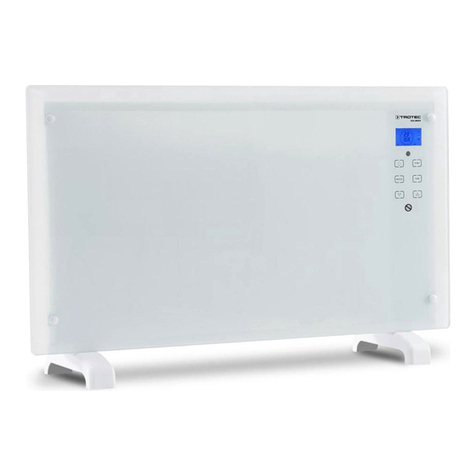
Trotec
Trotec TCH 2000 E operating manual
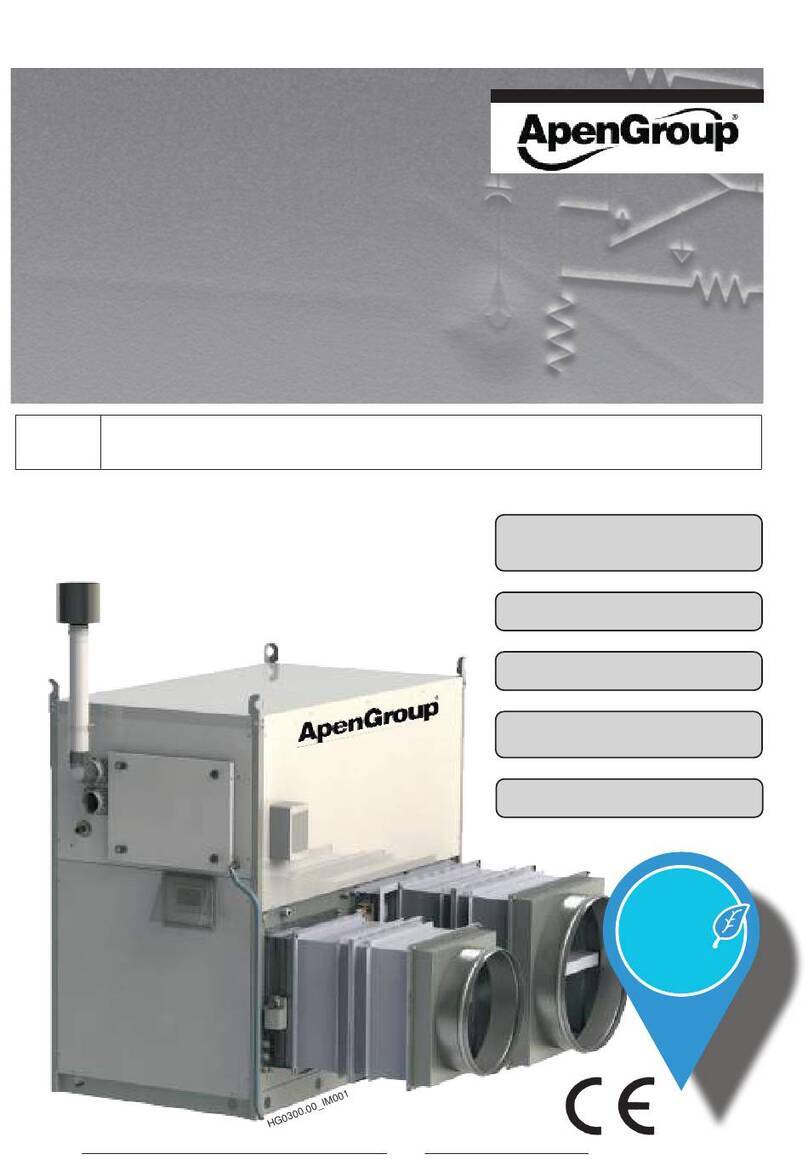
ApenGroup
ApenGroup AH-Sport manual

AKO
AKO K 811 Installation and operating instructions
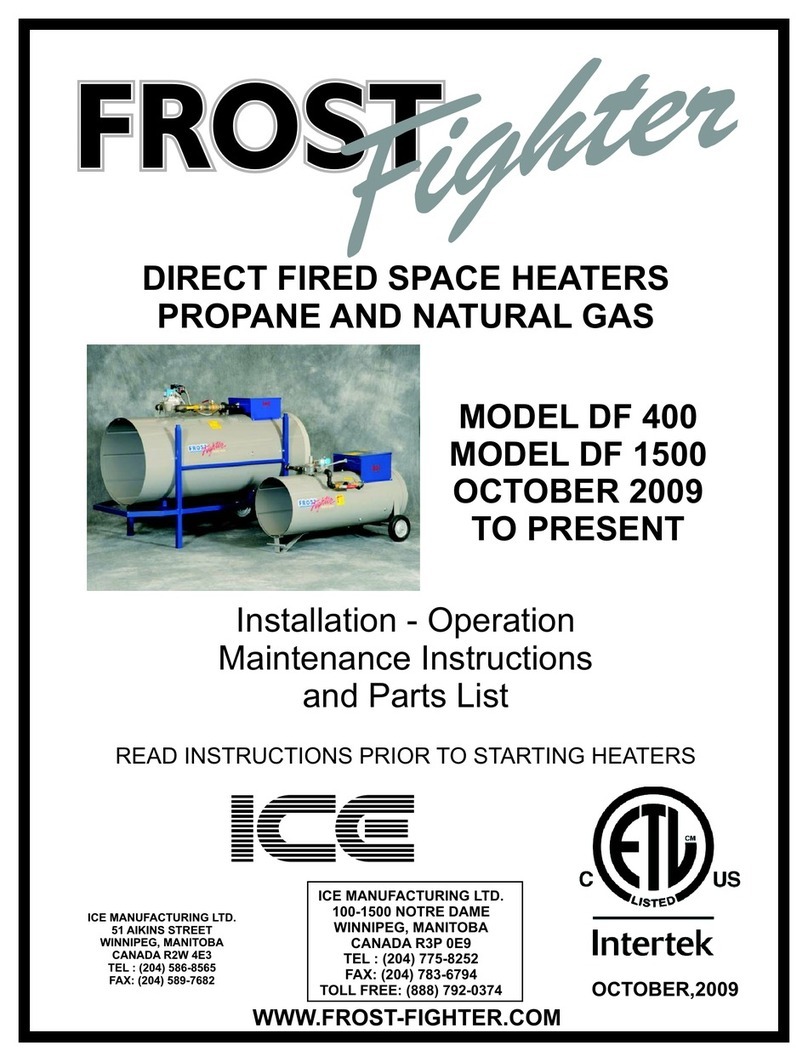
Frost Fighter
Frost Fighter DF 400 manual
